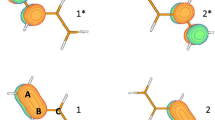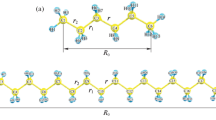Abstract
The role of long-range interactions has been considered in the case of polyene chains containing up to 100 CH groups with consideration of the interaction of the π electrons with the Pariser-Parr-Pople Hamiltonian in the self-consistent-field approximation (by the Hartree-Fock and spin-unrestricted Hartree-Fock methods), and the energies of the first optical excitation, the densities of the one-electron states, and the distribution of the bond orders along the chain have been found. The question of the existence of states with spin-density waves and bond-order waves in a linear polyene has been investigated.
Similar content being viewed by others
Literature cited
C. K. Chiang, C. R. Fincher, Y. W. Park, et al., “Electrical conductivity in doped polyacetylene,” Phys. Rev. Lett., 39, No. 17, 1098–1101 (1977); Erratum, ibid., 40, No. 22, 1472 (1978).
C. K. Chiang, M. A. Druy, S. C. Gau, et al., “Synthesis of highly conducting films of derivatives of polyacetylene (CH)x,” J. Am. Chem. Soc., 100, No. 3, 1013–1015 (1978).
T. C. Clarke, R. H. Geiss, J. F. Kwak, and G. B. Street, “Highly conducting transition metal derivatives of polyacetylene,” J. Chem. Soc., Chem. Commun., No. 12, 489–490 (1978).
M. Audenaert, “Indirect observation of the semiconductor-metal transition in AsF5-doped trans-polyacetylene,” Phys. Rev., B, 30, No. 8, 4609–4616 (1984).
A. Heeger, “Semiconducting and metallic polymers: new science with potential for new technology,” Comm. Solid State Phys., 10, No. 2, 53–63 (1981).
W. P. Su, J. R. Schrieffer, and A. J. Heeger, “Soliton excitations in polyacetylene,” Phys. Rev., B, 22, No. 4, 2099–2111 (1980).
A. E. Belinskii, I. A. Misurkin, A. A. Ovchinnikov, and I. I. Ukrainskii, “Vibrational frequencies and equivalence of bonds in polyacetylene,” Teor. Éksp. Khim., 18, No. 4, 403–408 (1982).
P.-O. Löwdin, “Theory of many-particle systems. 3. Extension of the Hartree Fock scheme to include degenerate systems and correlation effects,” Phys. Rev., 97, No. 6, 1509–1520 (1955).
P.-O. Löwdin, “Limits of the band model and transitions to the metallic state,” in: Quantum Theory of Atoms, Molecules, and the Solid State, Academic Press, New York-London (1966), pp. 601–623.
R. Pauncz, Alternant Molecular Orbital Method, Saunders, Philadelphia (1967).
J. Des Cloizeaux, “Étude des transitions entre états métalliques et isolants. Application aux bandes d'impurété et aux antiferromagnètiques. 1,” J. Phys. Radium, 20, No. 8/9, 606–750 (1959).
J. Des Cloizeaux, “Étude des transitions entre états métalliques et isolants. Application aux bandes d'impurété at aux antiferromagnètiques. 2,” ibid., pp. 751–763.
I. A. Misurkin and A. A. Ovchinnikov, “Electronic structure of long molecules with conjugated bonds,” Pis'ma vZh. Éksp. Teor. Fiz., 4, No. 7, 248–252 (1966).
I. A. Misurkin and A. A. Ovchinnikov, “Electronic structure of long molecules with conjugated bonds,” Teor. Éksp. Khim., 3, No. 4, 431–436 (1967).
I. A. Misurkin, A. A. Ovchinnikov, and G. A. Vinogradov, “Electronic structure and collective excitations of long molecules with conjugation in the main chain,” Int. J. Quant. Chem., 9, No. 4, 605–625 (1975).
I. A. Misurkin, A. A. Ovchinnikov, and G. A. Vinogradov, “Collective electronic excitations in long molecules with conjugated bonds (cyclic and linear polyenes),” Teor. Éksp. Khim., 10, No. 6, 723–731 (1974).
G. A. Vinogradov, I. A. Misurkin, and A. A. Ovchinnikov, “Thermally excited paramagnetism of macromolecules with conjugated bonds,” ibid., 12, No. 6, 724–731 (1976).
I. A. Misurkin and A. A. Ovchinnikov, “Electronic structure and properties of polymeric molecules with conjugated bonds,” Usp. Khim., 46, No. 10, 1835–1870 (1977).
I. Fischer-Hjalmars, “Basis Orbitals and the zero differential overlapping approximation,” in: Modern Quantum Chemistry, Part I, Academic Press (1965), p. 203.
K. Nishimoto and N. Mataga, “Electronic structure and spectra of nitrogen heterocycles,” Z. Phys. Chem. Neue Folge, 13, No. 2, 140–157 (1957).
H. Fukutome and M. Sasai, “Theory of electronic structures and lattice distortions in polyacetylene and inherent Peierls systems. 1. UHF transfer matrix method adapted to the long-range Coulomb interaction and UHF states in regular bond alternated lattice,” Progr. Theor. Phys., 67, No. 1, 41–67 (1982).
I. A. Misurkin and A. A. Ovchinnikov, “Influence of the long-range art of the electrostatic repulsion of electrons on the nature of the ground state of polymers with conjugated bonds,” Teor. Éksp. Khim., 12, No. 3, 291–298 (1976).
H. Fukutome, “Unrestricted Hartree-Fock theory and its applications to molecules and chemical reactions,” Int. J. Quant. Chem., 20, No. 5, 955–1066 (1981).
J. Paldus and E. Chin, “Bond length alternation in cyclic polyenes. 1. Restricted Hartree-Fock method,” ibid., 24, No. 4, 373–394 (1983).
G. Kventzel, “Peierls- and Mott-type instabilities in one-dimensional chains — coexistence or contradiction,” ibid., 22, No. 4, 825–835 (1982).
B. Hudson, B. Kohler, and K. Schulten, “Linear polyene electronic structure and potential surfaces,” Excited States, 6, 1–95 (1982).
Author information
Authors and Affiliations
Additional information
Translated from Teoreticheskaya i Éksperimental'naya Khimiya, Vol. 22, No. 2, pp. 146–153, March–April, 1986.
We thank A. E. Belinskii for participating in obtaining some of the results on the influence of the long-range electrostatic interactions on the electronic structure of cyclic polyenes and A. L. Chugreev for participating in continual discussions.
Rights and permissions
About this article
Cite this article
Kon, A.Y., Misurkin, I.A. Electronic structure of long polyene chains with consideration of long-range electrostatic effects and the influence of the terminal groups. Theor Exp Chem 22, 134–141 (1986). https://doi.org/10.1007/BF00519183
Received:
Issue Date:
DOI: https://doi.org/10.1007/BF00519183




